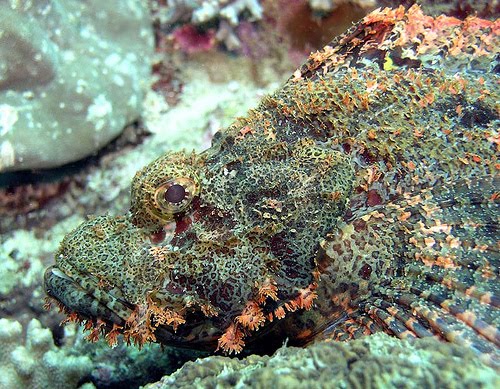

Very hot water (not scalding) is recommended to relieve the pain, but in every case, you should seek medical attention. By all reports, the pain becomes more intense within minutes to the extent that you can become immobilized with the pain. Time is of the essence if it is a stonefish sting. If you see a red dot or prick point that is painful and possibly oozing blood, look for medical attention and ask for help asap. If there’s no sign of anything sharp, check the bottom of your foot. It might be a piece of coral or sharp piece of broken shell. If you step on something sharp at low tide or in the ocean check your foot immediately. What Should You Do if Stung?Ī stonefish sting is a medical emergency. The following video by National Geographic provides a dramatic presentation of the hypodermic action of one of the spines as it shoots venom into the air. A human foot stepping down on the needle-sharp spines would put pressure on the venom sacs, shooting a steady stream of venom out through the ends of the spines directly into the foot. When the animal is disturbed, it raises its dorsal spines vertically as a defense mechanism. Source: William Smith, American Museum of Natural History. Credit: Graham Roberts, The New York Times. Illustration showing Stonefish spine and venom sac. Only after I draw the outline of the fish and its eyes and mouth do they exclaim, “Yes, I finally see it!” How is the Venom Injected?Įach of the thirteen needle-sharp spines along the dorsal fin is a hollow tube that acts like a hypodermic needle with its own venom sac. Even after I tell folks they are looking at a stonefish, they have trouble seeing it. I often show audiences a photograph of a stonefish lying on the sea bottom among the rocks and coral.

In my science presentations on board cruise ships I like to give people a bit of a heads up concerning some of the dangers they might face, especially in tropical waters (for example, see my article on the potentially deadly Irukandji jellyfish). Ask the locals – if stonefish live nearby they will likely have some scary stories to tell! I urge you to use extreme caution walking on exposed tidal flats any place stonefish can be found. They are also capable of sitting exposed to the air for several hours during low tide, so you could find yourself stepping on a fish that is out of the water! A very painful experience! Please remember – these creatures are so well camouflaged that they are almost invisible in their native habitat. Use extreme caution while walking on tidal flats or splashing through water at low tide. You could easily step on a stonefish at low tide because they are so well-camouflaged that you would have little likelihood of seeing one in time. What Makes Stonefish Invisible? The stonefish is a master at making itself invisible by blending in with its surroundings. There are five species of stonefish throughout the world, with an average length of 30 to 40 cm (12-16 in) and up to 2 kg (5 lbs) in weight. Now that they have been introduced to Florida and the Caribbean, they are considered the most dangerous fish in that region as well. There are roughly 800 to 1,000 stings reported every year in Australia alone, and stonefish are the likely cause of death for many people living on the shores of the Pacific and Indian Oceans. According to the National Institutes of Health in the USA “stonefish are one of the most venomous fish in the world with potential fatal local and systemic toxicity effects to humans.” Even if treated promptly, recovery from a stonefish sting “usually takes about 24 to 48 hours.” Getting stung by a stonefish can cause excruciating pain. Originally native to the Pacific and Indian Ocean, they are now found throughout Florida waters and the Caribbean. Needle-sharp spines can inject a toxic venom that can cause excruciating pain and potentially even death. The biggest danger is accidentally stepping on one since they are almost invisible at low tide.

The Stonefish is the most venomous fish in the ocean and many people have died after getting stung by one. Here’s one fish that I’m glad I’ve never encountered in its natural habitat! I’ve written this article in the hope that this information can help prevent accidental and potentially life-threatening encounters with the most venomous fish in the world.


 0 kommentar(er)
0 kommentar(er)
